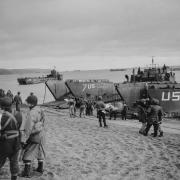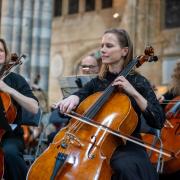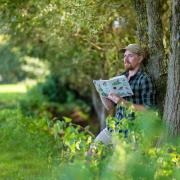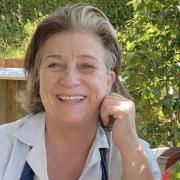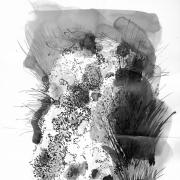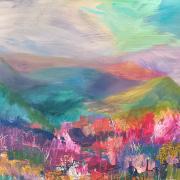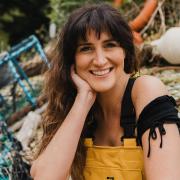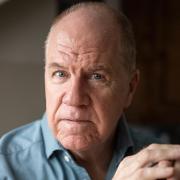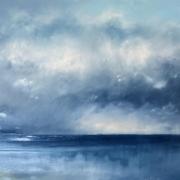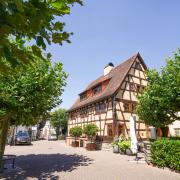Could an inherent appreciation of nature and new found freedom be the link between Totnes sculptor Kari Furre’s fascination with working with fish leather and her passion for wild swimming, asks Fran Mcelhone?

When I first met Kari a few months ago, she told me that her fascination creating and sculpting fish leather was subconsciously linked with her amphibious alter ego.
“I’m working on that link, between sculpture and swimming,” the 66-year-old tells me six months on. “I want to integrate my life. I know it’s all coming from the same place; that love for the landscape and the natural environment.”
Kari is a sculptor and long distance, wild swimmer (although she doesn’t call it “wild”, just “going for a swim”). A filmmaker recently made a short film about her life for the Kendal Mountain Festival. It featured the merwoman’s epic, 17km bisection of England’s largest lake, Lake Windermere in the Lake District last summer, accompanied by two friends, her son on a paddleboard and a friend in a motorised boat.
The film pleased her, because it gave her the opportunity to contemplate the correlation between her love affair with water and freedom as an independent sculptor.
Because, although always a keen pool swimmer, the outdoor swimming really established itself after her itinerant 20-odd year career working in repertory theatre and subsequent career as a fabricator for British-Nigerian artist Yinka Shonibare MBE.
It it was since becoming free from the ties of the day job, that Kari became free to follow her heart more with sculpture. Light floods into the upstairs of Kari’s Halbertonford home, which doubles up as her studio after she bashed through a few walls – “I’ll probably never sell it!”. Downstairs, her quintessential English country cottage with fish print wallpaper (made out of old curtains), is scattered with Kari’s organic and intricate fish leather and metalwork sculptures which she has exhibited at London Design Week and Dartington Hall.
Her first foray with leather came in the ‘80s when she made five fine Commedia dell’arte masks while working on a Shakespeare production. These are pinned to the beams in her sitting room. “At the time, the men I was working with had such a thing about what materials were legitimate, like bronze and stone,” she recalls. “They were not only sniffy about materials, but women sculptors too. But I thought, leather lasts for hundreds of years, just look at Roman sandals – it’s a wonderful material.”

Kari started working with fish leather around six years ago, after a visit to Iceland where she spotted a “rather ugly” array of bags and bracelets. But Kari was intrigued and returned to learn the skill from a fellow artist. She tells me her interest in fish leather is a nod to her Norwegian roots (her father was Norwegian, her mother from Totnes).
Salmon and cod are her favourite fish for working with she says, unrolling a batch. “They make brilliant leather,” she says, introducing me to some leather covered boxes, bowls and books. “Salmon I can do all sorts with,” she says. Plaice, I see, also makes an incredibly delicate translucent piece of material, and gurnard skin, a particularly beautiful bowl.
Kari tans with egg yolk, fat and soap, or willow bark. “I’m very technique led,” she says. “And I don’t really plan what I’m making. It’s a sort of hand to brain process. I make something, and then find out what I’m thinking! It takes a while for an idea to ferment.”
Kari sources her fish from restaurateurs in Brixham. They expect her occasional unannounced call, when she’ll stock up and put a batch in her freezer. “Sometimes I get my fish from Morrisons, have it for my tea, and then make something out of the skin,” she smiles. “I love the up-cycle element; the skins would otherwise go to waste. But fish leather is really something only suitable to be made in the Northern Hemisphere. It warps if it’s too humid.”
Kari’s work is based around the natural environment but she is an extremely experimental artist, and if you’re at all squeamish, look away now, because she is currently tanning the skins of rodents caught by her friend’s cat. She shows me the skins of a mole, a shrew and a mouse in her sketch book – “a place to put things so you don’t lose them” – from which I learn that in the 17th century women used to make eyebrows out of shrews’ tails. We admire how eyebrow-like a tail she has pinned to a page really is. Kari then presents me with a cast she recently took of a cat skeleton she found on the side of the road. “I went back and cast it right there on the roadside,” she says.
When she’s not making, Kari, who is a director of the Outdoor Swimming Society, is swimming.
Her favourite spots include Thurlestone Rock to Hope Cove in the South Hams, the 3.5km section of the Dart from Totnes to Dartington, and the 6km stretch downstream from Aveton Gifford to Bantham along the River Avon.
“The nice thing about swimming is that middle aged ladies with a layer of subterranean fat which aids buoyancy, can be really good at it, but young athletic teenage boys can sink to the bottom,” she laughs.
“People swim for different reasons. I like the journey. There’s something very special about immersing yourself in the landscape, and for me, it comes from the creative part of my brain. You get a heightened sense of being; I describe my swimming as being yogic in nature, an art process rather than a sport.”




